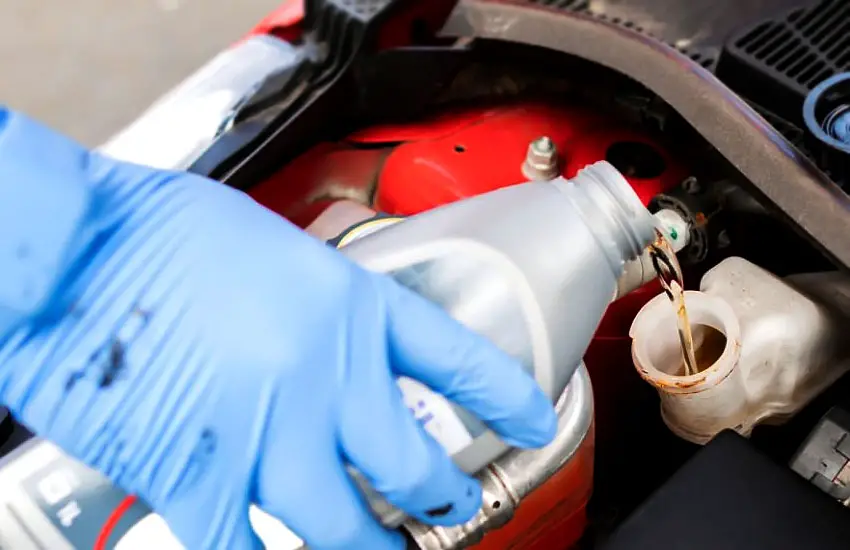As an Amazon Associate, I earn from qualifying purchases at no extra cost to you.
How to Drain Transmission Fluid: Step-by-Step Guide
You might be wondering how to drain transmission fluid. This is an important job for keeping your car running smoothly. If you don't change the fluid, it can get dirty and cause problems for your transmission. In this article, we'll show you easy steps to drain the old fluid and add new fluid. Don’t worry if you haven’t done this before; we'll explain everything in simple words. Whether you’re a car expert or just starting out, this article will help you learn how to take care of your car’s transmission like a pro!
How to Drain Transmission Fluid: Step-by-Step Guide

Step 1: Gather Your Tools and Materials
Before you start draining the transmission fluid, make sure you have all the necessary tools and materials. You’ll need:
- Safety gloves and goggles
- A socket set
- A wrench
- A transmission fluid pump
- A drain pan
- New transmission fluid
- A funnel
- A jack and jack stands (or ramps)
Step 2: Prepare Your Vehicle
Once you have your tools, it's time to prepare your vehicle for the job. Preparing your vehicle is very important for your safety and to make the work easier. First, park your car on a flat surface. This will help the fluid drain out completely and prevent spills. A level surface ensures that the fluid flows correctly.
Once the car is parked, engage the parking brake. This is a safety step that keeps the car from rolling while you are working under it. Next, you need to lift the vehicle. Use a jack to raise the car off the ground. After raising it, place jack stands underneath the car to support it. This is very important to ensure the car is stable and safe while you work underneath it.
If you don't have jack stands, you can drive the car up on ramps. Always check to make sure the vehicle is stable before you crawl underneath it. You can also wear safety glasses and gloves at this stage to protect yourself. Make sure you are in a well-lit area so you can see everything clearly. Preparing your vehicle properly will help you work safely and make the draining process go smoothly.
Taking these steps seriously will prevent accidents and ensure you can complete the job without any problems. Proper preparation sets the foundation for a successful transmission fluid change.
Step 3: Locate the Transmission Drain Plug
Now that your vehicle is ready, it is time to find the transmission drain plug. Finding the drain plug is important because that is where the old transmission fluid will come out. The drain plug is usually located at the bottom of the transmission pan. To locate it, you can start by consulting your owner's manual. The manual will often have a diagram or description of where to find the drain plug for your specific vehicle model.
If you do not have the manual, you can look underneath the vehicle. As you lie under the car, look for a round plug that looks different from the other bolts. This is usually a larger and flatter piece. You may need to clean the area around it to see it clearly. It is important to identify the correct plug to avoid draining the wrong fluid. If you still have trouble finding it, you can ask a friend or look for online videos that show how to find the drain plug for your car.
Remember, each vehicle may be different, so take your time and make sure you have the right location before proceeding to the next step. Finding the drain plug accurately will make the next steps easier and more efficient. Once you have located the drain plug, you will be ready to drain the old transmission fluid.
Step 4: Drain the Old Transmission Fluid
Now it's time to drain the old transmission fluid. Draining the old fluid is a very important step in this process. First, make sure you have placed your drain pan underneath the drain plug. The pan will catch all the old fluid when it starts to come out. This is a very important step to prevent messes on the floor. A clean workspace helps keep things organized and safe.
Next, you will need to remove the drain plug. Use your wrench or socket to carefully loosen and remove the plug. When you remove the plug, be careful because some fluid may start to spill out right away. It is a good idea to step back and let the fluid drain into the pan. Allow the old transmission fluid to drain completely. This process might take a few minutes, so be patient.
Do not rush; give the fluid time to flow out. As the fluid drains, you can take this time to clean the drain plug if it is dirty. Make sure the area is free from debris before replacing the plug. Once all the fluid has drained, make sure to replace the drain plug securely. You don't want any leaks when you put the new fluid in. Be sure to use your wrench to tighten the plug back in place. Once you have completed this step, you are ready to move on to adding new transmission fluid.
Step 5: Add New Transmission Fluid
After you have drained the old fluid, it is time to add the new transmission fluid. Adding new fluid is essential to keep your transmission working well. First, locate the transmission dipstick tube. This tube is usually near the back of the engine and can be identified by a brightly colored handle. Once you have found it, it is a good idea to use a funnel to help pour the new fluid in without making a mess.
Insert the funnel into the dipstick tube carefully. Next, it's time to pour in the new transmission fluid. Make sure to use the correct type of fluid, which you can find in your owner's manual. Pour the fluid slowly into the funnel, allowing it to flow into the transmission. It is important to go slowly so you don't overflow the funnel.
After adding some fluid, remove the funnel and check the fluid level using the dipstick. Wipe the dipstick clean, reinsert it, and then pull it out to check the level. If the fluid is low, you can add more until it reaches the right level. It is very important not to overfill it. If you add too much fluid, it can cause problems with your transmission. Once you are happy with the fluid level, replace the dipstick and put the funnel away. You are now ready to start the engine and check for any leaks.
Step 6: Start the Engine and Check for Leaks
Once you've added the new fluid, it's time to start the engine and check for leaks. This step is important to ensure everything is working correctly. First, make sure you are safely in the vehicle with your foot on the brake. Start the engine and let it run for a few minutes. This allows the new transmission fluid to circulate throughout the system. You may hear the engine running smoothly, which is a good sign.
While the engine is running, you should shift the transmission through each gear, from park to reverse to drive, and then back to park again. This step helps the new fluid reach all parts of the transmission. After shifting through the gears, it is a good idea to turn off the engine and carefully get out of the vehicle. Look under the car to check for any leaks around the drain plug or the transmission pan.
If you notice any leaks, this could mean the drain plug is not tightened properly. You can go back and check it to make sure it is secure. Once you are satisfied that there are no leaks and everything is working properly, you can turn off the engine. This ensures that your new fluid is in place and your transmission is ready to go. Checking for leaks is crucial to avoid future problems.
Step 7: Dispose of the Old Fluid Properly
After completing the job, it is very important to dispose of the old transmission fluid properly. Used transmission fluid can be harmful to the environment, so we must handle it carefully. First, make sure to pour the old fluid from the drain pan into a sealed container. It is best to use a container that will not leak, such as an empty oil bottle or a dedicated fluid container. This helps to prevent spills and keeps the fluid contained.
Once you have transferred all the old fluid into the container, make sure to label it clearly. This will help anyone who handles it know that it contains used fluid. The next step is to take the container to a recycling center or an auto parts store. Many auto parts stores offer recycling services for used fluids and will dispose of them safely. You can also check local regulations to see if there are any specific guidelines for disposing of hazardous waste in your area.
By disposing of the old fluid correctly, you help protect the environment and ensure that it is handled safely. This step is just as important as changing the fluid itself, so never skip it! Proper disposal shows you care for the environment and your community. Doing this helps everyone and keeps our planet clean.
I hope this guide helps you understand how to drain your transmission fluid. Keeping your vehicle's transmission fluid fresh is important for smooth driving. By following these steps carefully, you can take good care of your car. Always remember to dispose of the old fluid properly. Taking care of your car helps it run better and last longer.
Are these Questions in Your Mind?
Is it necessary to change transmission fluid regularly?
Yes, it is necessary to change transmission fluid regularly to keep your transmission running smoothly. Over time, the fluid can get dirty and lose its effectiveness. Following the manufacturer's recommendations for changing the fluid helps prevent problems.
Can I use any type of transmission fluid for my car?
No, you should not use just any type of transmission fluid. Each vehicle requires a specific type of fluid based on its make and model. Always check your owner's manual to find the right fluid for your car.
Do I need special tools to drain the transmission fluid?
You don't need a lot of special tools, but a few basic ones are helpful. A socket set, wrench, and funnel are essential. You might also need a transmission fluid pump for adding new fluid easily.
Is it safe to drain transmission fluid myself?
Yes, it is generally safe to drain transmission fluid yourself if you take the right precautions. Make sure to work in a safe environment and use proper tools. Always wear gloves and safety glasses for protection.
Can I skip changing the transmission filter when I change the fluid?
It is not recommended to skip changing the transmission filter. The filter helps keep the fluid clean by trapping dirt and debris. Replacing it ensures that the new fluid stays clean and works effectively.
Do I need to warm up my engine before changing the transmission fluid?
Yes, warming up your engine slightly can help the transmission fluid flow better. Warm fluid drains out more easily, making the process smoother. Just let the engine run for a few minutes before starting the job.
Is it normal for transmission fluid to smell burnt?
No, it is not normal for transmission fluid to smell burnt. A burnt smell can indicate that the fluid is old or that there is a problem with the transmission. If you notice this smell, it's important to check the fluid and the transmission.
Can I mix different brands of transmission fluid?
It is not recommended to mix different brands of transmission fluid. Different brands may have different additives that can affect performance. Always use the same brand or type recommended for your vehicle.
Do I have to lift my car to drain the transmission fluid?
Yes, you usually need to lift your car to drain the transmission fluid properly. This allows you to access the drain plug easily. Make sure to use a jack and jack stands or ramps for safety.
Is it okay to drive with low transmission fluid?
No, it is not okay to drive with low transmission fluid. Low fluid levels can cause transmission problems, such as slipping or overheating. If you suspect low fluid, check it immediately and add more if needed.











